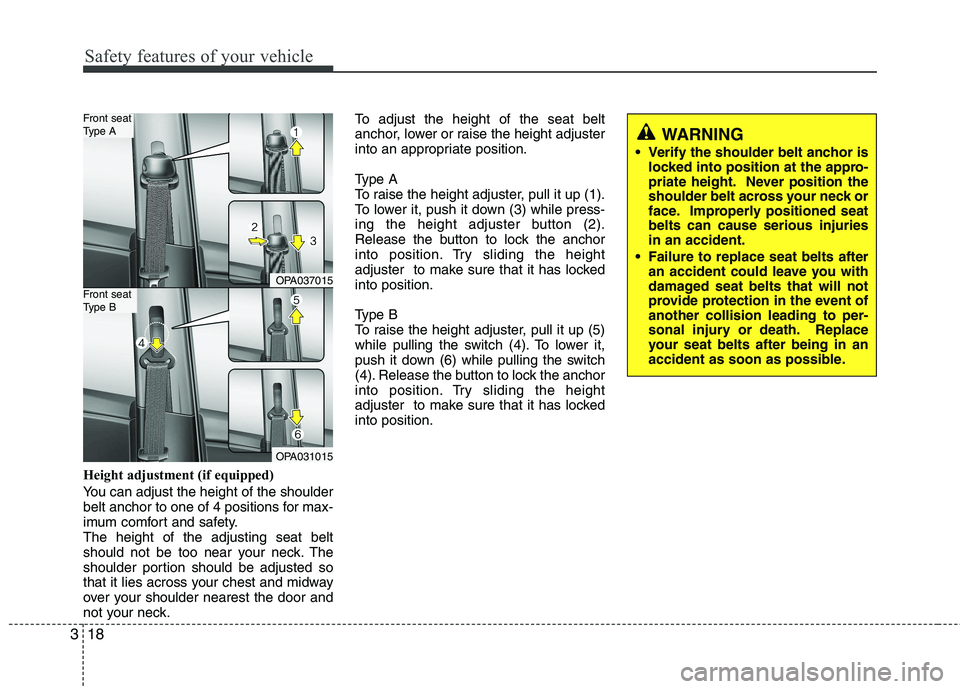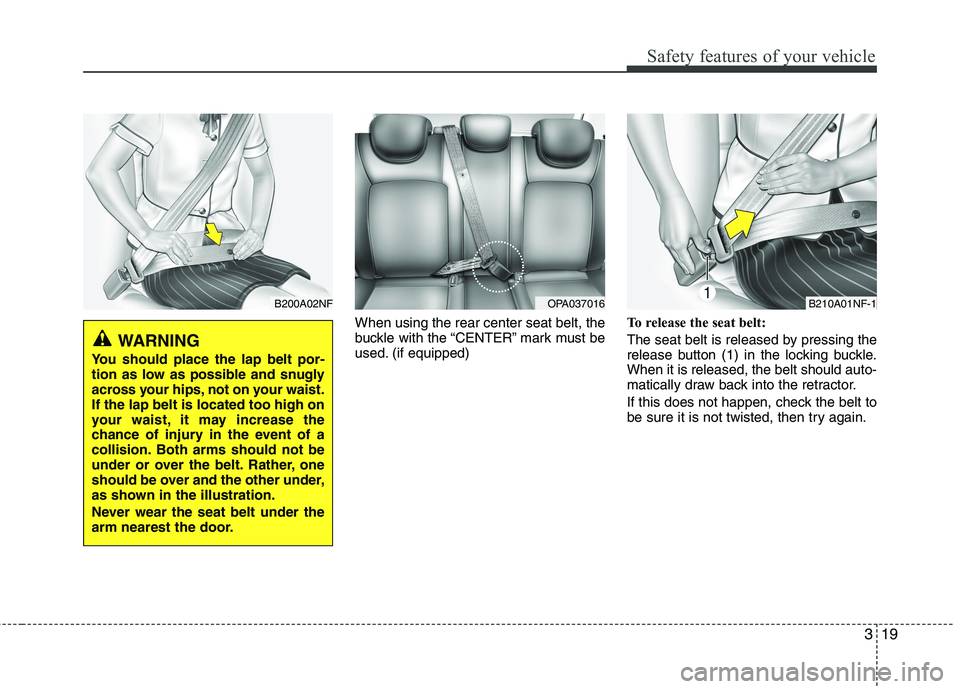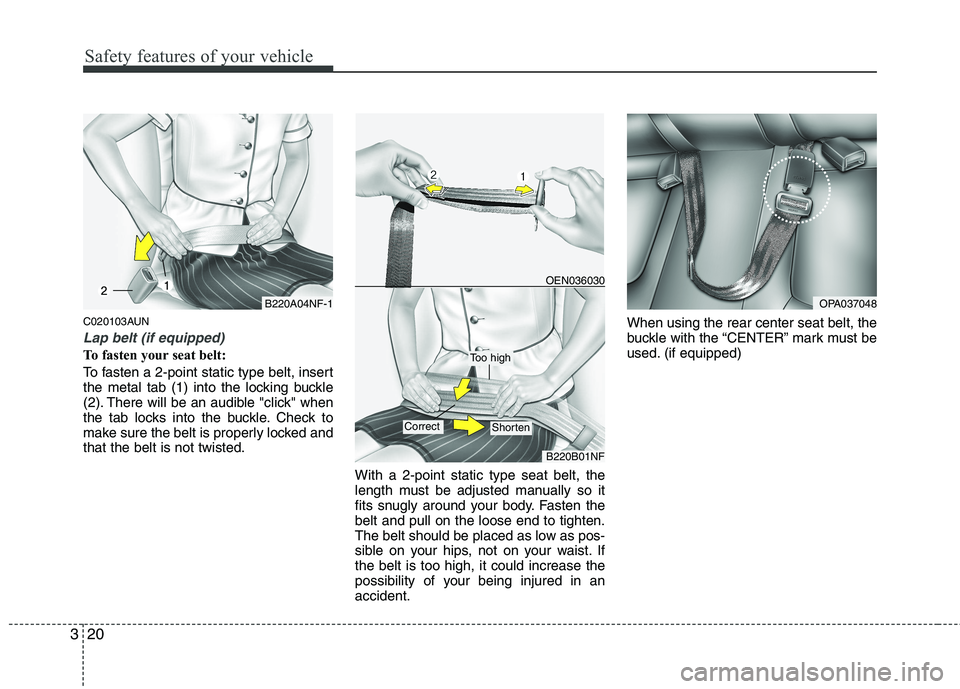2007 HYUNDAI I10 lock
[x] Cancel search: lockPage 32 of 354

313
Safety features of your vehicle
4. Insert the rear lap/shoulder belt plateinto the holder on the side trim not to
interfere with the seatback when fold-
ing down.
5. Pull up the rear seatback folding lever(s) and fold the rear seatback for-
ward and down firmly. 6. To use the rear seat, lift and push the
seatback backward. Push the seat-
back firmly until it clicks into place.
Make sure the seatback is locked in
place.
7. Return the rear seat belt to the proper position.
OPA037045
OPA037050
Type B
Type A
OPA037046
OPA037051
Type B
Type A
WARNING
When you return the rear seatback to its upright position after being
folded down:
Be careful not to damage the seat
belt webbing or buckle. Do not
allow the seat belt webbing or
buckle to get caught or pinched in
the rear seat. Ensure that the seat-
back is completely locked into its
upright position by pushing on the
top of the seatback. Otherwise, in
an accident or sudden stop, the
seat could fold down and allow
cargo to enter the passenger com-
partment, which could result in
serious injury or death.
Page 36 of 354

317
Safety features of your vehicle
Type B
As a reminder to the driver, the seat belt
warning light will illuminate for approxi-
mately 6 seconds each time you turn the
ignition switch ON. However, if the dri-
ver's seat belt is not fastened when the
ignition switch is turned ON or if it is dis-
connected after the ignition switch is
turned ON, the seat belt warning light will
illuminate until the belt is fastened.
If you drive over 9 km/h (6 mph) without
the driver's seat belt fastened (but when
the seat belt has been fastened beforeand when the 100 second chime has
never been completed), the seat belt
warning light will blink and the chime will
sound for 100 seconds.
If you drive over 9 km/h (6 mph) without
the driver's seat belt fastened (but when
the seat belt has never been fastened orwhen the 100 second chime has been
completed even if the seat belt has been
fastened before), the seat belt warning
light will blink. And then the seat belt
warning chime will sound for 100 sec-
onds if you drive over 20 km/h (12.5 mph)
(but when the 100 second chime has
never been completed).
If the driver's seat belt is disconnected
when you drive over 9 km/h (6 mph), the
seat belt warning light will blink and the
chime will sound for approximately 100
seconds.
If the driver's seat belt is fastened while
the seat belt warning chime sounds, the
chime will stop at once.C020102BPA
Lap/shoulder belt
To fasten your seat belt:
To fasten your seat belt, pull it out of the
retractor and insert the metal tab (1) into
the buckle (2). There will be an audible
"click" when the tab locks into the buckle. The seat belt automatically adjusts to the proper length only after the lap belt por-
tion is adjusted manually so that it fits
snugly around your hips. If you lean for-
ward in a slow, easy motion, the belt will
extend and let you move around. If there
is a sudden stop or impact, however, the
belt will lock into position. It will also lock
if you try to lean forward too quickly.
✽✽
NOTICE
If you are not able to pull out the seat
belt from the retractor, firmly pull the
belt out and release it. Then you will be
able to pull the belt out smoothly.
WARNING
The center seat belt latching mech-
anism is different from those for the
rear side seat belts. When fasteningthe rear side seat belts or the cen-
ter seat belt, make sure they are
inserted into the correct buckles to
obtain maximum protection fromthe seat belt system and assure
proper operation.
B180A01NF-1
Page 37 of 354

Safety features of your vehicle
18
3
Height adjustment (if equipped)
You can adjust the height of the shoulder
belt anchor to one of 4 positions for max-
imum comfort and safety.The height of the adjusting seat belt
should not be too near your neck. The
shoulder portion should be adjusted so
that it lies across your chest and midway
over your shoulder nearest the door and
not your neck. To adjust the height of the seat belt
anchor, lower or raise the height adjuster
into an appropriate position.
Type A
To raise the height adjuster, pull it up (1).
To lower it, push it down (3) while press-
ing the height adjuster button (2).
Release the button to lock the anchor
into position. Try sliding the height
adjuster to make sure that it has lockedinto position.
Type B
To raise the height adjuster, pull it up (5)
while pulling the switch (4). To lower it,
push it down (6) while pulling the switch
(4). Release the button to lock the anchor
into position. Try sliding the height
adjuster to make sure that it has lockedinto position.
WARNING
Verify the shoulder belt anchor is locked into position at the appro-
priate height. Never position the
shoulder belt across your neck or
face. Improperly positioned seatbelts can cause serious injuriesin an accident.
Failure to replace seat belts after an accident could leave you with
damaged seat belts that will not
provide protection in the event ofanother collision leading to per-
sonal injury or death. Replace
your seat belts after being in an
accident as soon as possible.
OPA037015
OPA031015
Front seat
Type B
Front seat
Type A
Page 38 of 354

319
Safety features of your vehicle
When using the rear center seat belt, the
buckle with the “CENTER” mark must be
used. (if equipped)To release the seat belt:
The seat belt is released by pressing the
release button (1) in the locking buckle.When it is released, the belt should auto-
matically draw back into the retractor.
If this does not happen, check the belt to
be sure it is not twisted, then try again.
B200A02NF
WARNING
You should place the lap belt por-
tion as low as possible and snugly
across your hips, not on your waist.If the lap belt is located too high on
your waist, it may increase the
chance of injury in the event of a
collision. Both arms should not be
under or over the belt. Rather, one
should be over and the other under,
as shown in the illustration.
Never wear the seat belt under the
arm nearest the door.
B210A01NF-1OPA037016
Page 39 of 354

Safety features of your vehicle
20
3
C020103AUN
Lap belt (if equipped)
To fasten your seat belt:
To fasten a 2-point static type belt, insert
the metal tab (1) into the locking buckle
(2). There will be an audible "click" when
the tab locks into the buckle. Check to
make sure the belt is properly locked andthat the belt is not twisted.
With a 2-point static type seat belt, the
length must be adjusted manually so it
fits snugly around your body. Fasten thebelt and pull on the loose end to tighten.
The belt should be placed as low as pos-
sible on your hips, not on your waist. Ifthe belt is too high, it could increase the
possibility of your being injured in anaccident.When using the rear center seat belt, the
buckle with the “CENTER” mark must be
used. (if equipped)
B220A04NF-1
OEN036030
B220B01NF
Too high
ShortenCorrect
OPA037048
Page 40 of 354

321
Safety features of your vehicle
To release the seat belt:
When you want to release the seat belt,
press the button (1) in the locking buckle.C020105APA
Stowing the rear seat belt
The rear seat belt buckles can bestowed in the pocket between the rear
seatback and cushion when not in use.
(Type A)
The center seat belt can be stowed with the plate and webbing rolled in the
pocket in the rear seatback. (Type B) C020200AEN Pre-tensioner seat belt (if equipped)
Your vehicle is equipped with driver's and front passenger's pre-tensioner seat
belts. The purpose of the pre-tensioner is
to make sure that the seat belts fit tightly
against the occupant's body in certain
frontal collisions. The pre-tensioner seat
belts may be activated in crashes where
the frontal collision is severe enough.
B210A02NF-1
OPA037017
OPA037047
Type B
Type A
OEN036300
Page 41 of 354

Safety features of your vehicle
22
3
When the vehicle stops suddenly, or if
the occupant tries to lean forward too
quickly, the seat belt retractor will lock
into position. In certain frontal collisions,
the pre-tensioner will activate and pullthe seat belt into tighter contact against
the occupant's body.
If the system senses excessive seat belt
tension on the driver or passenger's seat
belt when the pre-tensioner activates, theload limiter inside the pre-tensioner willrelease some of the pressure on the
affected seat belt. (if equipped)
The seat belt pre-tensioner system con-
sists mainly of the following components.
Their locations are shown in the illustra-tion:
1. SRS air bag warning light
2. Retractor pre-tensioner assembly
3. SRS control module
1LDE3100
WARNING
To obtain maximum benefit from a pre-tensioner seat belt:
1. The seat belt must be worn cor- rectly and adjusted to the proper
position. Please read and follow
all of the important information
and precautions about your vehi-
cle’s occupant safety features –
including seat belts and air bags
– that are provided in this manu-al.
2. Be sure you and your passen- gers always wear seat belts prop-
erly.
Page 47 of 354

Safety features of your vehicle
28
3
WARNING
To reduce the chance of serious or fatal injuries:
Children of all ages are safer when restrained in the rear seat.
A child riding in the front passen-
ger seat can be forcefully struck
by an inflating air bag resulting inserious or fatal injuries.
Always follow the child restraint system manufacturer’s instruc-
tions for installation and use of
the child restraint.
Always make sure the child seat is secured properly in the car and
your child is securely restrained
in the child seat.
Never hold a child in your arms or lap when riding in a vehicle. The
violent forces created during a
crash will tear the child from your
arms and throw the child against
the car’s interior.
Never put a seat belt over your- self and a child. During a crash,the belt could press deep into the
child causing serious internalinjuries.
(Continued)(Continued)
Never leave children unattendedin a vehicle – not even for a short
time. The car can heat up very
quickly, resulting in serious
injuries to children inside. Even
very young children may inadver-
tently cause the vehicle to move,entangle themselves in the win-
dows, or lock themselves or oth-
ers inside the vehicle.
Never allow two children, or any two persons, to use the sameseat belt.
Children often squirm and repo- sition themselves improperly.
Never let a child ride with theshoulder belt under their arm or
behind their back. Always proper-
ly position and secure children inthe rear seat.
Never allow a child to stand-up or kneel on the seat or floor of a
moving vehicle. During a colli-
sion or sudden stop, the child
can be violently thrown against
the vehicle’s interior, resulting in
serious injury.
(Continued)(Continued)
Never use an infant carrier or achild safety seat that "hooks"
over a seatback, it may not pro-vide adequate security in an acci-dent.
Seat belts can become very hot, especially when the car is parked
in direct sunlight. Always check
seat belt buckles before fasten-
ing them over a child.